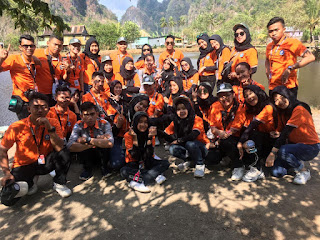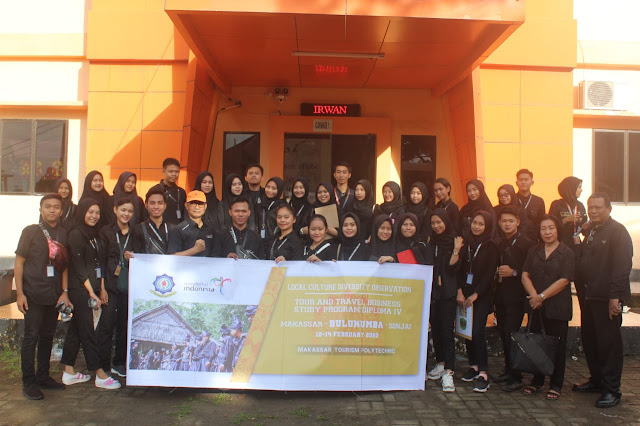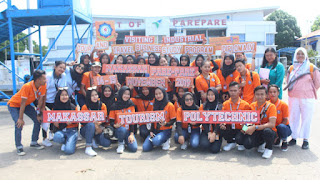LOKAL CULTURE ( MAROS-PANGKEP)
Assalamualaikum..
 Ammarung means "bunyi". The name Ammarung is taken from the roar of water that splits the amarrung field. One resident said, in the Ammarung field there were springs in the rocks that flowed like fast water in Bantimurung, but when we went there was a long dry season, so we could not see the water.
Ammarung means "bunyi". The name Ammarung is taken from the roar of water that splits the amarrung field. One resident said, in the Ammarung field there were springs in the rocks that flowed like fast water in Bantimurung, but when we went there was a long dry season, so we could not see the water.
My name is liza. I am a semester 1 student in Makassar tourism polytechnic. Department of travel business. On this occasion, I will share my first experience of doing a tour with classmates, tour leaders and lecturers.
Our tour this time was called local culture. We visited two tourist destinations namely Maros Regency and Pangkajene Islands Regency. We took this trip for two days. We didn't stay there so we just had a round trip. We went there using two buses, we are 33 students, 2 tour leaders ( Sandi Siswanto & Greisna ) , 2 advisors ( Sir Rusdi & Ma'am Mila ), and 2 vendors (A. Juli Jumratu Ni'mah & Arini )
The first day, Thursday, October 17, 2019 at 07:42 we left for the maros district, expecially Rammang-rammang in Salenrang village, Bontoa district. We arrived there, welcomed by the heat of the sun which made us even more excited to sail the waters of the rammang-rammang using a boat.
 |
| PERAHU MELINTASI PERAIRAN RAMMANG RAMMANG |
We took a boat about 25 minutes to get to the mainland. When we reached the mainland we walked to a food stall and a place of rest. We gathered and listened to the direction of the tour leader. we were assigned to make observations to several tourist attraction in the village. And we also started to make observations with group friends who have been shared by our tour leader.
The first observation is to kingkong stone.
But before that, we approached one of the houses to find information about the village. her name is Hasnah, she is a native of the village. he explained that the village only had a population of 18 families. Mrs. Hasnah has sales like cold drinks in the area, and she tells us that there are also ponds in which there are sponge fish, tilapia, and Sitto shrimp. The water they use daily comes directly from the mountain and now in the village is experiencing a long dry season.
Why is it called Kingkong Stone? Because the stone is very similar to a large kingkong head. In this kingkong stone, for the entrance fee, you just pay a little. To get to this place, we have to walk like a climber, because this rock is quite high. We were careful enough to cross it, but Alhamdulillah we arrived safely.
 |
| BEKAS JEJAK KAKI AYAM |
Not far from the location of the kingkong stone, there are footprints of chicken imprints on the edge of the rocks. Because this place used to be a place to "menyabung ayam", they really liked this activity.
watch carefully :D
Then the next observation, namely to the "Ammarung desert". Across this Ammarung desert we walk on stony cement which has a rather high ladder, and below, we can see views of the village with several ponds and high karst mountains.
When we arrived at the top, there were a number of colorful chairs facing the beautiful mountains into a cool photo spot. There are also several resting places that can be rented one night for 10 thousand per person. One resident said, in the Ammarung field there were springs in the rocks that flowed like fast water in Bantimurung, but when we went there was a long dry season, so we could not see the water.
 Ammarung means "bunyi". The name Ammarung is taken from the roar of water that splits the amarrung field. One resident said, in the Ammarung field there were springs in the rocks that flowed like fast water in Bantimurung, but when we went there was a long dry season, so we could not see the water.
Ammarung means "bunyi". The name Ammarung is taken from the roar of water that splits the amarrung field. One resident said, in the Ammarung field there were springs in the rocks that flowed like fast water in Bantimurung, but when we went there was a long dry season, so we could not see the water.  |
| lanscape beautiful mountain |
Our last observation is towards the top of the diamond cave. At the diamond cave, we also made a little climb. The entrance fee at that place you only "merogoh kocek" 5 thousand rupiah per person. once there, it turns out there is a small and dark cave, then we climb the stairs that are very narrow and dark with the help of our tour leader Mr. Sandy, we also reached the top. I was very amazed to see it, what I saw was giant octopus fossils, there were also large coral fossils which, if flicked, produced a bit of rhythm, there were also diamonds around these fossils and also we saw human-shaped "male" stones. use skull cap "hat" which is said to say he was meditating and asking for knowledge. This village was once a large lake.
And in this diamond cave is the bottom of the lake
 |
| BERBENTUK ORANG SEDANG BERTAPA |
 |
| FOSIL GURITA RAKSASA |
My impressions and messages during the first day tour:
I feel happy and excited because this is my first time to go to rammang rammang. A very cool adventure and a lot of knowledge that I got.
The second day, we visited Pangkep Regency. In Pangkep we visited 4 places, namely the traditional market of Pangkep, Pandai Besi , BATARI (Bandeng Tanpa Duri) and mangrove forests.
Our trip at that time was no less enthusiastic than yesterday's trip. At the same time we headed to the district of Pangkep.
And our first group observation was at the traditional market in Pangkep.
Then we visited the blacksmith. This blacksmith's place of manufacture belongs to the late. Location on Ambarala Timur street. Pak Kamaruddin, who was then forwarded by his son named Pak Arifuddin and Pak Irfan. Iron produced in this place is the best quality iron and many of the other regions that order such as from Tarakan, Irian, Kendari, Kolaka and others. In this place has 3 workers, who produce 15 machetes and the like in 1 day. When making a machete only takes less than 1 hour. This ironworker was founded 60 years ago. They work every day except Friday to Sunday at 08:00 to 15:00.
They produce various types of sharp objects such as Badik, pisau, linggis, tombak (poke’), tang (sipi’), parang.
There are some basic ingredients of making such as per, plat, besi kanada (besi ulir), pipa.
LOGO
Then we visited the making of boneless milkfish. BATARI was established in 2014. Precisely in the village of Bulucindea, Bungoro sub-district, Pangkep district. Employ local residents such as mothers and teenagers who drop out of school. The motivation for making boneless milkfish is that he has surveyed a lot of people who don't like milkfish because they have a lot of bones. Therefore BATARI is opened. They use tweezers and anatomical scissors to separate the milkfish from their bones. 1 milkfish takes about 5 to 10 minutes. Their attention is to complete 100 milkfish. In 1 fish milkfish consists of 164 bones. On the back 42, in the middle of the stomach 16, and on the tail 12. The omset of this business is 90 million rupiah.
1 kg = 5 milkfishes, 1 milkfish = 200 g.
This place not only produces boneless milkfish but also produces foods such as abon, crackers, flour, nuggets, and otak otak. the price of milkfish is 200 gr 10 thousand rupiah. 250 gr 12 thousand rupiahs, 300 gr 15 thousand rupiahs.
Our last observation is towards the mangrove forest. in the mangrove forest has many beautiful and cool photo spots with awesome sunset views. People not only use this place as a place to tour but also where they look for shells / oysters and crabs.
that was my first experience with friends visiting these extraordinary places. very fun, and very educational. Wait for us at your place!
Assalamualaikum..
Sayoonara...
#salampesonaIndonesia























Nice blog sis ❤️❤️
BalasHapusKeren👍
BalasHapusMantap... Keren, saya sandi tour leader saat melakukan perjalanan ini, saya merasa sangat senang bisa melakukan perjalanan bersama kalian😉 trip kali ini seru dan asik sekali
BalasHapus.
.
.
Semoga nanti kita bisa jalan jalan bersama kalian lagi
Aamiin. Yaps😉
HapusKeren sekali 😊😊😊
BalasHapusKeren👍👍👍
BalasHapusPerfect 😍
BalasHapusnice lisa😊, semangat yaa bikin konten blog nya
BalasHapusKeren
BalasHapusNice liza 😍
BalasHapusJalan2 yg menyenangkan itu adalah jalan2 yg di dlmx ada kesenangan ada kebahagiaan ada kebersamaan ada cinta ada ilmu
BalasHapus